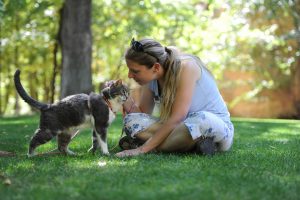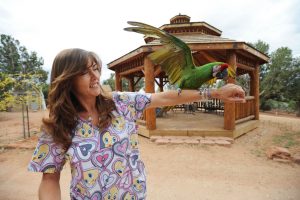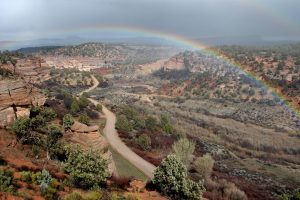Tucked into a twisting canyon lined with tawny cliffs in southern Utah is a refuge for more than 1,600 companion animals, including dogs, cats, donkeys, horses, potbellied pigs, goats, parrots, and other furry and feathered friends. Some animals await adoption into a new family while others live out their lives in peace here. The Best Friends Animal Society, a non-profit organization, operates the refuge a scant five miles north of Kanab in Angel Canyon, a gorgeous slice of red-rock heaven floored by meandering Kanab Creek.
Best Friends calls itself “the nation’s largest no-kill safe haven for displaced, homeless, or unwanted domestic animals.” The society, a world leader in the no-kill movement, has succeeded admirably, saving tens of thousands of animals at its refuge. It’s also formed partnerships with cities, including Los Angeles, New York, and Atlanta, to end shelter deaths, and it boasts a network of more than 1,000 partner organizations committed to the no-kill movement.
Kanab Welcomes Best Friends in 1984
The Best Friends Animal Society started in the late 1970s when a group of friends established a small animal sanctuary on a ranch near Prescott, Arizona. Over the next few years, the group looked for a larger place during their travels around the American West. In June 1982, one of the organization’s co-founders, Francis Battista, drove north toward Salt Lake City and stopped in Kanab, a frontier town east of Zion National Park. He inquired about nearby land for sale and was told to check out Kanab Canyon north of town.
The site was perfect. The group purchased the canyon and began building the refuge in February 1984, erecting the first buildings, finding water, making homes for their rescued animals, and changing the valley’s name to Angel Canyon. Kanab opened its arms and welcomed the newcomers and their love for all animals. From those humble beginnings, Best Friends has become the largest employer in Kane County and continues to lovingly maintain this animal Eden.
Pioneering Animal Rescue

Kane County
Best Friends has practiced a no-kill philosophy by not euthanizing healthy pets because of space or behavioral issues. By treating animals with kindness, respect, and compassion, the organization almost single-handedly created today’s no-kill movement. The Society works with humane groups around the country to save homeless pets while advocating for spay and neuter sterilization programs to reduce the number of unwanted animals.
Animals stay at Best Friends until they find forever homes. Humane euthanization is only used if the animals are sick, injured, or dying. Unlike some shelters, animals are not killed to make space for more animals. Between 6 and 8 million dogs and cats flood into animal shelters in this country every year, with as many as 2 million euthanized. That’s far less than the 17 million killed annually when Best Friends was founded in 1984. Best Friends has adopted a Save Them All call-to-action, and its goal is to end the killing of homeless animals by 2025.
(Based on World Animal Foundations most recent data, these figures have been updated, and according to the latest research and data, around 920,000 Shelter Animals are Euthanized each year including 390,000 Dogs and 530,000 Cats. Source)
The Largest No-Kill Animal Sanctuary in the United States
Best Friends animal sanctuary sprawls across 3,700 acres in a high desert canyon, surrounded by another 33,000 acres leased from the Bureau of Land Management. The sanctuary uses about 300 acres for companion animals and lets local wildlife, including turkeys, deer, coyotes, squirrels, snakes, and birds, thrive on the rest of the undeveloped property. Starting with a small staff, Best Friends has grown to employ more than 400 people who maintain the sanctuary and care for the 1,600 animals that call Angel Canyon their home.
A Haven for Animals and Pets of All Kinds

Kane County
The sanctuary is a big place that’s divided into different animal sectors, like Dog Town, which has been featured on the National Geographic Channel. There’s also Cat World, Piggy Paradise, Horse Haven, Bunny House, and Parrot Garden, an aviary filled with parakeets, cockatiels, and macaws. The massive size of the property allows the different areas to be separated—Horse Haven is three miles away from Dog Town.
The refuge protects more than 800 cats and 500 dogs. It provides rehabilitation for injured wildlife, including around 300 hawks and eagles annually. Every day the critters are fed and provided with human companionship. Volunteers walk leashed dogs that wear a green collar to indicate that they are people-friendly. Other helpers socialize with cats, cuddle a friendly rabbit, or take an animal on a field trip to Kanab or nearby attractions. Dogs are well cared for at Dog Town Heights, where canines live in eight-sided buildings. There’s even a doggie fitness center for rehabilitation after injury or surgery.
Some dogs live permanently at the sanctuary because they can’t be adopted, but they receive plenty of staff attention and spend much of their time outside. Cat World features 11 buildings, which allows the felines to live in small groups. Prospective adopters can walk a cat in a harness or cat stroller. The Best Friends animals receive medical care in a geothermally heated, high-tech hospital that puts most veterinary clinics to shame—a far cry from the sanctuary’s original Airstream trailer clinic.
Experience the Best Friends Sanctuary

Kane County
The Best Friends animal refuge attracts more than 30,000 annual visitors who tour the grounds, walk the dogs, pet the cats, and volunteer for other essential tasks. Tours and visits with the companion animals are available every day (except for Christmas) year round. Starting at the Welcome Center, an hour-and-half guided tour explores the scenic sanctuary on a six-mile loop road with stops at the different animal communities. Specialty tours are also available, as are guided hikes in Angel Canyon on Thursdays and Sundays. After a morning tour, visitors are welcome to sample the vegan buffet served daily in the dining room. You can, of course, bring your own leashed pet on the tour, although Best Friends asks you not to bring them into buildings that house the adoptees.
Of course, Best Friends would love for you to give an animal a forever home. Information on adoption can be found here, and for visitors from far, the property offers cottages, cabins, and RV sites where you can spend the night. But whether you’re able to adopt a pet or not, you will enjoy spending time at Best Friends and seeing the incredible work done here. It doesn’t take much time at Best Friends to understand why its message is so powerful—and how it has been successful in making such a significant impact on our culture.
Written by Stewart Green for Matcha in partnership with Kane County.